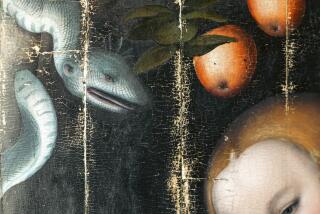ART REVIEW : Renaissance Air in the Getty’s ‘Choir Books’
- Share via
The J. Paul Getty Museum is up to another of its wonderful little vest-pocket exhibitions that illuminate illuminated manuscripts from its collection. This one presents 17 books and pages on the subject “Illuminated Choir Books of the Middle Ages and Renaissance.”
If a single vision swims to mind in contemplating these objects, it’s the notion of proliferating detail and interpenetrated arts. All served as scripts for the celebration of faith. Their public theaters were the great, endlessly elaborated cathedrals. Their music the ever more richly encrusted sound of polyphony.
Manuscripts themselves combined the arts of writer, bookmaker, composer, calligrapher and storytelling painter. Single pages encompass squared musical notation, text in Gothic script, an initial letter entwined with a biblical scene, floral motifs and gargoyles, each set off against its own little zone of gold. A particularly rich example is a missal ascribed to the Master of the Brussels Initials from about 1400. Its pages are like pictures of the medieval mind busily creating categories and sub-categories, then uniting them all with a Catholic conclusion.
Even the choir books were separated into types according to various contents and functions. Antiphonals were typically very large so they’d be visible to singers grouped around them. One on view from 13th-Century Bologna runs to 500 pages. Missals were smaller books the faithful could consult during services. Breviaries and graduals served variations on these uses, but, taken together, all bespeak a steeply hierarchical universe presumably leveled by a common belief. Assistant curator Elizabeth Teviotdale, who organized the show, points out that those who sang from the books ranged from such cloistered monks and nuns as the Cistercians and Dominicans to more secular and political clergy, such as canons and cardinals.
Bureaucracies and established religions tend to be inert and conservative. Given that, it’s not surprising that these choir books, lovely as they are, lag somewhat behind their times. They bracket history from the 13th to the 16th centuries. By the time the last of them were made, the classic High Renaissance period was over.
The good news is that the manuscript makers were so sufficiently in touch with the new art that it had a refreshing effect on their world. An initial from 13th-Century Bologna depicts Christ in Majesty. The general composition still adheres to the stiff conceptual canon of the Byzantine, but such telling details as the treatment of drapery show a loosening similar to that of proto-Renaissance artist Cimabue. Manuscript painter Lippo Vanni caught up with Masaccio’s atmospheric perspective late in the 15th Century.
Among the most surprising of these hip manuscript artists was one in the circle of Pisanello. He did a scene depicting the conversion of St. Paul that brings to mind the battle scenes of Uccello. Another artist known only as the Master B.F. painted an initial showing Noah directing the construction of the ark. Landscape in the background shows the clear influence of Leonardo, with its blue atmosphere and craggy rocks.
On the other hand, being abreast of the trends is not necessarily ultimate virtue. The lovely ideals represented by the more traditional choir books turn up in a gradual probably made in Antwerp about 1497. The unknown artists’ depiction of the Virgin suckling the infant Christ is set in an austere courtyard castle. As heartfelt and sweet as a great piece of folk art, it perfectly captures that moment when austere winter is about to change to a shyly smiling spring.
J. Paul Getty Museum, 17985 Pacific Coast Highway, Malibu; through July 9, closed Mondays, advance parking reservations required, (310) 458-2003.
More to Read
The biggest entertainment stories
Get our big stories about Hollywood, film, television, music, arts, culture and more right in your inbox as soon as they publish.
You may occasionally receive promotional content from the Los Angeles Times.










